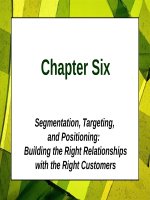Lecture Principles of Marketing - Chapter 14: Marketing in the digital age
Bạn đang xem bản rút gọn của tài liệu. Xem và tải ngay bản đầy đủ của tài liệu tại đây (236.8 KB, 29 trang )
Chapter Fourteen
Marketing in the
Digital Age
Roadmap: Previewing the Concepts
1.
2.
3.
4.
5.
Discuss how the digital age is affecting both
consumers and the marketers who serve them.
Explain how companies have responded to the
Internet and other powerful new technologies
with e-business strategies, and how these
strategies have resulted in benefits to both
buyers and sellers.
Describe the four major e-marketing domains.
Discuss how companies go about conducting
e-marketing to profitably deliver more value to
customers.
Overview the promise and challenges that
e-commerce presents for the future.
Copyright 2007, Prentice Hall, Inc.
14-2
Case Study
Amazon.com – Online Pioneer
Background
Began selling books; now
markets many other
merchandise lines.
One of the best known
names on the Web.
Sales have been strong
but firm did not turn a
profit until 2003.
Skeptics predict tougher
times in years to come.
Marketing Efforts
Customer-driven: strives to
design the best customer
experience on the Web.
Personalized sign-on pages
and recommendations,
huge selection, good value,
and convenience result in
strong buyer relationships.
Will Amazon become the
Wal-Mart of the Web?
Forces Shaping the Digital
Age
Digitalization andConnectivity
– Intranets
• connect people within a company.
– Extranets
• connect a company with its suppliers,
distributors, and outside partners.
– Internet
• connects users around the world.
Forces Shaping the Digital Age
Internet Explosion
– Explosive worldwide growth forms the
heart of the New Economy.
– Increasing numbers of users worldwide,
and broadband users in the U.S.
– Greater numbers of consumers are
accessing information on the Internet.
– Companies must adopt Internet
technology or risk being left behind.
Marketing Strategy in the
Digital Age
Requires a new model for marketing
strategy and practice.
Companies need to retain old skills and
practices but add new competencies.
E-Business in the Digital Age
Involves the use of electronic platforms
to conduct company business.
– Web sites for selling and customer
relations.
– Intranets for within-company
communication.
– Extranets connecting with major suppliers
and distributors.
E-Commerce in the Digital Age
More specific than e-business.
Involves buying and selling processes
supported by electronic means,
primarily the Internet.
Includes:
– e-marketing
– e-purchasing (e-procurement)
E-Marketing in the Digital Age
The marketing side of e-commerce.
Includes efforts to communicate about,
promote, and sell products and
services over the Internet.
E-purchasing is the buying side of
e-commerce.
– It consists of companies purchasing
goods.
Benefits to Buyers
Convenience.
Buying is easy and private.
Provides greater product access and
selection.
Provides access to comparative
information.
Buying is interactive and immediate.
Benefits to Sellers
Powerful tool for building customer
relationships.
Can reduce costs.
Can increase speed and efficiency.
Offers greater flexibility in offers and
programs.
Is a truly global medium.
E-Marketing Domains
Business to consumer (B2C)
Business to business (B2B)
Consumer to consumer (C2C)
Consumer to business (C2B)
Business to Consumer (B2C)
The online selling of goods and
services to final consumers.
– Expected to generate $316 billion in 2010,
or 13% of retail sales.
– There is increasing diversity in buyers.
• This provides increasing opportunities
for targeting markets.
– Is customer initiated and controlled,
requiring new marketing approaches.
Business to Business (B2B)
B2B sales dwarf B2C sales:
– B2B e-commerce was nearly $4 trillion in 2003.
– Uses trading networks, auction & barter sites, spot
exchanges, online product catalogs, and more.
Most major B2B marketers offer online
product information, purchasing, and support.
Open trading exchanges:
– huge specialty e-marketspaces to conduct
transactions.
More private trading exchanges are being
developed for B2B transactions.
Consumer to Consumer (C2C)
Occurs on the Web and includes a wide
range of products and services.
– Auction sites such as eBay offer
marketplaces to buy or exchange goods.
– Blogs and forums facilitate information
interchanges.
• Blog: online journals where people post
thoughts on a narrowly defined topic.
• Forums: discussion groups located on
commercial online services.
Consumer to Business (C2B)
Consumers can search out sellers,
view offers, initiate purchases, and give
feedback.
– Example: on priceline.com, one can bid for
airline tickets, hotel rooms, etc., and
decide whether to accept company offers.
Click-Only Companies
E-tailers
Search engines and portals
Shopping comparison sites
Internet service providers
Transaction sites
Content sites
Reasons for dot.com Failures
Poor research or planning.
Relied on spin and hype instead of
marketing strategies.
Spent too heavily on brand identities.
Devoted too much effort to acquiring
new customers instead of building
loyalty.
Click-and-Mortar Companies
Established firms initially resisted adding
Web sites because of channel conflict and
cannibalization concerns.
Risk of online competition forced firms to
become click-and-mortar companies. Most
are now doing better than click-only
companies because of:
–
–
–
–
–
Trusted brand names and more resources
Large customer bases
More knowledge and experience
Good relationships with suppliers
Can offer customers more options
Online Marketing
Creating a Web site
Placing ads and promotions online
Setting up and participating in Web
communities
Using e-mail
Types of Web Sites
Corporate Web Site:
Designed to build customer goodwill
and supplement other sales channels.
– Offers information to customers.
– Builds closer customer relationships.
– Generates excitement about the company.
Types of Web Sites
Marketing Web Site:
Engages consumers in an interaction
that moves them closer to a direct
purchase or other marketing outcome.
– May include catalogs, shopping tips,
promotional features, and more.
Designing Attractive Web Sites
The 7 Cs of Effective Web Site Design:
–
–
–
–
–
–
–
Context
Content
Community
Customization
Communication
Connection
Commerce
Constant change helps encourage repeat
visits.
Online Ads
Forms of online advertising:
– Banner ads:
• Tickers (move across the screen)
• Skyscrapers (tall, skinny ads at the side of a
page)
• Rectangles (boxes that are larger than a
banner)
– Interstitials (pop up OR pop under between
changes on Web site)
– Search-related ads (contextual advertising)
– Rich media ads (incorporate animation, video,
sound, and interactivity).
Online Promotion
Forms of online promotion:
– Content sponsorships (sponsoring special
content)
– Microsites (limited areas paid for by an
external company)
– Alliances and affiliate programs (work with
firms to promote each other)
– Viral marketing (Internet version of wordof-mouth)









